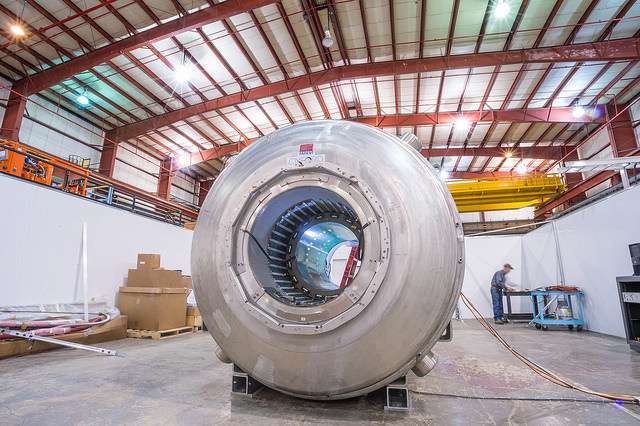Used MRI magnets get a second chance at life in high-energy physics experiments

When it comes to magnets, a doctor's trash is a physicist's treasure.
Researchers at the U.S. Department of Energy's (DOE) Argonne National Laboratory recently acquired two decommissioned magnets from magnetic resonance imaging (MRI) scanners from hospitals in Minnesota and California that will find a new home as proving grounds for instruments used in high-energy and nuclear physics experiments.
The two new magnets have a strength of 4 Tesla, not as strong as the newest generation of MRI magnets but ideal for benchmarking experiments that test instruments for the g minus 2 ("g-2") muon experiment currently being assembled at the DOE's Fermi National Accelerator Laboratory. The Muon g-2 experiment will use Fermilab's powerful accelerators to explore the interactions of muons, which are short-lived particles, with a strong magnetic field in "empty" space.
The experiment relies on highly precise measurements of the strong magnetic field; the magnets will greatly aid these measurements. "As we prepare for the g-2 experiment, we have to have a suitable test magnet to very carefully calibrate our magnetic field measuring probes ahead of time," said Argonne high-energy physicist Peter Winter, who was recently awarded a $2.5 million, five-year DOE Early Career Research Program Award.
To measure and calibrate the custom-built probes, Winter and his colleagues needed a magnet that could provide not only a strong field but one that was uniform and stable. Solenoid MRI magnets like the ones Argonne has acquired are perfect for that purpose.
In addition to their strength, these repurposed magnets offer another notable advantage: originally used as a human patient MRI magnet, they have a wide bore so that large detector components can easily fit inside.
"By using these new magnets, we can fit the entire half-meter-long probe system in the magnet, which will give us a very precise measurement of the intensity of the magnetic fields," Winter said. "These MRI magnets produce a very stable, homogenous magnetic field that is ideal and crucial for getting technology ready for the larger g-2 experiment."
Because the g-2 experiment is so large and requires precise calibration, researchers need to firmly understand any potential interactions between the strong magnetic field and the equipment. "We can now validate any equipment in our test magnet, which is incredibly important because it saves time and money when the time comes to actually do the experiment," Winter said.
Because the Minnesota magnet was sitting in storage for a few years, Argonne needed only to pay the shipping costs – a few thousand dollars – to acquire it. By comparison, buying a new magnet to do the benchmarking would have cost close to $1 million.
Even the more involved transport of the second San Francisco magnet was still cost-efficient. "We're saving taxpayer money by finding new and different uses for technology that may not have been intended for physics in the first place," Winter said. "In the future, we will use this new test magnet facility to develop and test large detector prototypes that need to operate in high magnetic fields. We are open for other users across the entire lab to facilitate research that requires strong magnetic fields in a large bore magnet."
The second magnet will become a component in a new spectrometer for studying nuclear reactions that occur in supernovae. This new spectrometer is proposed for the future Facility for Rare Isotope Beams (FRIB), a DOE user facility under construction at Michigan State University. "The acquisition of this magnet would allow us to construct a state-of-the-art spectrometer that uses the radioactive beams from FRIB at minimal cost," said Argonne nuclear physicist Birger Back.
Both magnets have already been delivered to Argonne, and Winter and his team have begun to set up the magnet in the high-bay area of building 366. He expects validation experiments to begin soon.
Provided by Argonne National Laboratory




















